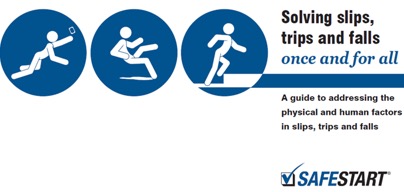Sometimes it’s impossible to control some physical hazards. Sudden snow falls, flash freezes and heavy rain or wind are the cause of many slips and falls because they alter the environment faster than we adjust to it.
One Step at a Time
Many slips, trips and falls are caused or made worse by a person’s state of mind. When we’re rushing, frustrated, tired or complacent we tend to make errors and decisions that increase the chance of injury. (E.g., walking faster than is safe for conditions, not keeping our eye’s or minds on the task of walking, not wearing proper footwear, response to hazards). When we start rushing or are frustrated or tired, the risk of slipping or tripping increases but our comfort level with walking stays the same.

Building better habits will reduce the risk of slips, trips and falls caused by the four states.
Important habits to reduce slips, trips and falls include the following:
- Always have one hand on the handrail when on stairs – be ready to grab handrail.
- Avoid carrying too much in your hands. Don’t let packages block your view.
- Avoid sudden pivoting/turns, rushing too fast, over-striding when walking.
- Be alert for trip hazards, ALWAYS stay vigilant and watch where you are going, see changes in elevation, cracks, uneven surfaces, and be aware of the surface you’re walking on.
- Clean up any spills immediately, post signs when housekeeping is mopping floors.
- Keep cords properly covered and keep papers and boxes out of walkways.
- Keep eyes and mind on task – walking – not reading a cell phone text, memo or written material.
- Look before moving – leaving a place of safety – and into vehicle traffic – is it safer to wait?
- Make sure file drawers are always kept closed after each use.
- Never stand on a chair to reach for something high – get a ladder or step stool.
- Slow down at corners and anticipate that other people might come into your path.
- Use 3-point contact on ladders and equipment and when getting out of vehicles.
- Walk at appropriate speeds for conditions – rain, ice, or snow.
- Wear appropriate footwear for your work environment – indoors or outdoors
Same Level Slips, Trips and Falls [4:08], video showing what hazards to look out for in an office setting.
